YOU CAN’T TWIN THEM ALL
There is nothing more fascinating for this Broadway musical aficionado than a flop’”but not for gloating purposes. It’s natural to wonder “What were they thinking?” with any train-wreck, but I’m obsessed with this particular branch of theater: With so many elements, a musical is one of the most difficult art forms to get right. Are the most successful shows paragons of perfect construction or are they a lucky confluence of artists available at that moment in history? Just as interesting are those flop musicals with some great songs and a troubled book (Chess, The Baker’s Wife). Problematic musicals such as these have a rabid fan base’”if not an audience’”and are occasionally retooled after an unsuccessful Broadway outing in the hopes of getting it right.
One thing is for sure. A great musical starts with a great book from which the songsmiths can determine which moments are worthy of musicalizing to heighten the emotional stakes. When that does not happen (which is often), we end up getting a musical with a great premise but only a few good songs. Welcome to Side Show, the musical about English Siamese twins Daisy and Violet Hilton, who in real life went from circus freaks to Vaudeville entertainers to a brush with movie fame in the 1920s and 30s but ended up as a market bagger and a checkout girl in Charlotte, North Carolina.
Back to rework, or rather overhaul, their 1997 Broadway flop are Henry Krieger (music) and Bill Russell (lyrics/libretto). The additional book material is by filmmaker Bill Condon, screenwriter of Chicago and screenwriter/director of Krieger’s Dreamgirls. Having seen the original version (with breakout performances by The Full Monty’s Emily Skinner and Next to Normal’s Alice Ripley), it is sad for me to report that the creators have traded one set of problems for another, as evidenced at the La Jolla Playhouse.
Condon has never directed for the theater but stages the show well; however, his book additions do not help Russell flesh out character development, often leaving his great performers nothing to work with. This book is actually darker than the original, but the biggest problem is that this tragic tale of misfits and unrequited love, while now less a backstage musical than a story about the turmoil of finding love and a “normal” life, is still treated basically as a musical comedy when the source material screams for a genre reinvention á la Cabaret or Sweeney Todd
A first act backstory right out of Les Miz is added, in which the girls are abused and raised by a Dickensian shrew, Auntie, who bought them from a mother who didn’t want them. When Auntie dies, her equally abusive (and also alcoholic) husband, Sir, names himself legal guardian and exploits the girls in a Texas side show. The flashback is the creators’ way of eliciting emotional investment from the audience but it backfires; skin-deep characters and uninteresting new songs only serve to halt the show’s momentum (and Sir’s motivations are one-dimensional, so we are uninvested when he returns in the second act to cash in on the twins’ burgeoning career).
A fallen theatrical agent named Terry arrives with his choreographer Buddy; they emancipate the girls from Sir and head to the Orpheum Circuit. The true background of these boys comes late into Act II, but by then it doesn’t matter that one had an illicit affair and the other is gay’”a major revelation that is tossed aside as soon as we hear of it. (And if Buddy is gay, his previous irony-free song begging for Violet’s hand is rendered disingenuous.) If this production is looking for sympathy from the audience, it would be best to have sympathetic characters, which these are not.
The individual freaks (excellent makeup design by Dave and Lou Elsey and Cookie Jordan) are all heroes, and the men are villains. All except Jake, the former side show Cannibal King who now stage manages the twins’ act; his profession of love for Violet, “You Should Be Loved,” may be a showstopper, but we have witnessed nary a hint of racism against this black man; as such, the song packs a wallop as a Broadway show tune, but there is no emotional investment in the character’s plight.
It is glaringly clear that even though the show is packed with potential, the problem with Krieger and Russell’s musical is Krieger and Russell. Oh, the boys can craft a song, but they never settle on the proper tone for this show. As with the first go-round, my biggest concern is Russell’s pedestrian, obvious lyrics, which are never more than serviceable and fail to plumb the depths of the American Dream and the consequences of fame. He also needs another Thesaurus since he runs out of synonyms for “conjoined.”
There is a quasi-operatic feel to the music in that a sort of recitative gives way to songs, similar to Dreamgirls. Yet while the songs in Dreamgirls all have a Motown/80s sound, the song styling in Side Show is all over the map. For example, the girls’ power ballads’”the Act I closer “Who Will Love Me as I Am” and the eleven o’clock number “I Will Never Leave You”’”are inspiring, stand-alone, slick 80s pop tunes that fit neither time nor place; and the opening number, which invites us to “Come Look at the Freaks,” begins with a sinister and haunting refrain, but then suddenly delves into a brassy, 1970s Broadway bounce, sung by the motley crew at hand.
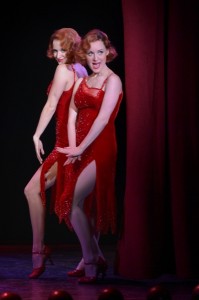 Far and away, the best and most memorable songs’”some of which are new to the musical’”use pastiche to evoke the years surrounding the Depression. The Vaudeville numbers “Stuck with You” and “One Plus One Equals Three” are delightful, and the ragtime-infused “Typical Girls Next Door” fits the context perfectly. But overall, the 30 songs (including reprises) are forgotten as they’re heard.
Far and away, the best and most memorable songs’”some of which are new to the musical’”use pastiche to evoke the years surrounding the Depression. The Vaudeville numbers “Stuck with You” and “One Plus One Equals Three” are delightful, and the ragtime-infused “Typical Girls Next Door” fits the context perfectly. But overall, the 30 songs (including reprises) are forgotten as they’re heard.
This production mirrors the twins’ predicament: If surgery is performed to separate them, one or both may die. I think the major surgery executed on this show may have killed all future prospects. Krieger and Russell are no slouches; they’re just out of their league with this material. Their children’s musical, Lucky Duck, is delightful, enchanting and, with plenty of adult humor and wonderful songs, deserves to be the main attraction. I love the story at hand, but I am left to wonder what Side Show would look like had it been filtered through the genius of Kander & Ebb or Sondheim.
photos by Kevin Berne
Side Show
in association with the John F. Kennedy Center for the Performing Arts
Mandell Weiss Theatre at La Jolla Playhouse
scheduled to end on December 15, 2013
for tickets, call (858) 550-1010 or visit http://www.LaJollaPlayhouse.org/
then plays John F. Kennedy Center June 14 – July 13, 2014
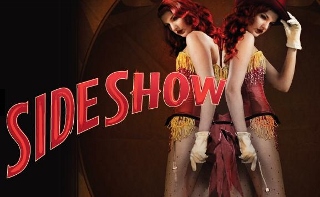
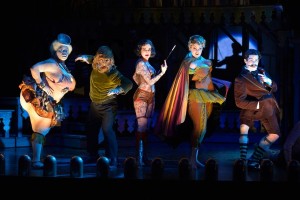
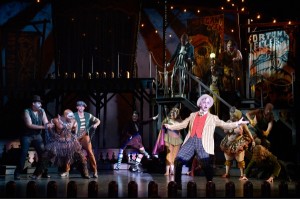
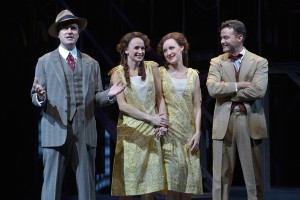
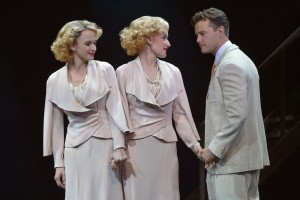
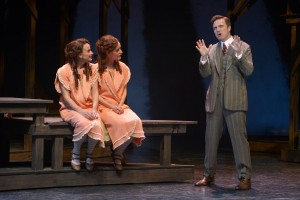
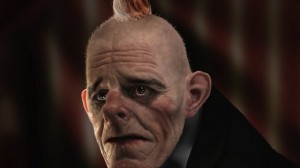

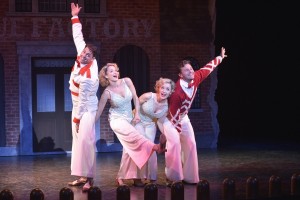

{ 1 comment… read it below or add one }
Mr. Frankel: Once again thanks for pulling no punches on your La Jolla’s SIDE SHOW review. I, too, witnessed the Broadway original production with outrage at the shallow and uninspiring take on these two individuals’ astounding journey. With groundbreaking dramatic predecessors such as THE MIRACLE WORKER and THE ELEPHANT MAN, it’s disappointing that SIDE SHOW’s creators couldn’t bring more depth to their musical exploration of what could have been an awe-inspiring look at the triumph of the human spirit. Thanks for saving me the trip down to La Jolla.